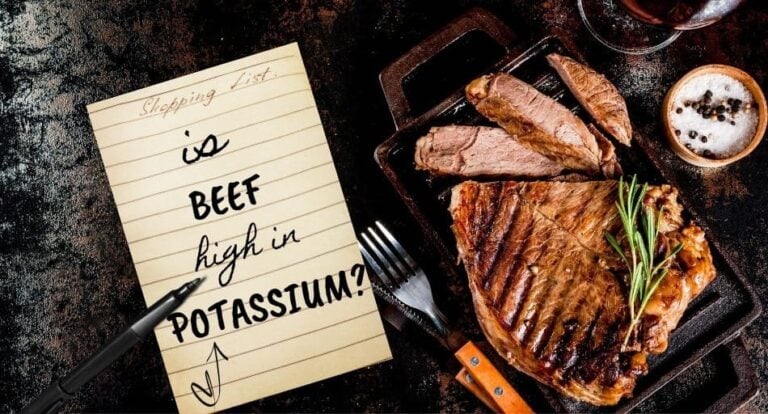Beef is a nutrient-dense food that contains various vitamins and minerals including potassium. Understanding how much potassium beef contains can help ensure you meet your recommended daily intake. This article provides a detailed look at the potassium levels in different cuts and preparations of beef.
Why Potassium Matters
Potassium is an essential mineral that plays numerous roles in the body, It
- Helps maintain fluid balance.
- Allows nerves to transmit impulses.
- Helps muscles contract.
- Maintains normal heart rhythm.
- Works with sodium to control blood pressure.
The recommended daily intake of potassium for adults is 4700mg However, most people only get about half that amount per day Meeting your potassium needs promotes heart health and reduces the risk of high blood pressure.
Consuming too little potassium can lead to muscle cramps, constipation, and abnormal heart rhythms. Getting adequate potassium from whole foods like beef can prevent deficiencies.
Potassium Levels in Beef
The potassium content of beef can vary based on the cut and preparation method. In general, a 3-ounce serving of lean beef contains around 300mg of potassium.
Here are the potassium levels for 3 ounces of some common beef cuts:
- Top sirloin: 337mg
- Bottom round roast: 318mg
- Top round steak: 311mg
- Eye of round: 308mg
- Ground beef, 90% lean: 279mg
While all cuts of beef contain potassium, select lean cuts tend to be higher. Extra lean ground beef provides the most, with 337mg per 3-ounce serving.
Potassium levels change somewhat based on how beef is prepared:
- Pan-fried top sirloin: 380mg
- Grilled top sirloin: 360mg
- Braised round steak: 330mg
- Roasted rump roast: 312mg
- Simmered beef chunks: 301mg
In general, dry heat cooking methods like grilling, broiling, and pan frying retain the most potassium. Moist cooking techniques like braising result in some mineral losses.
Getting Your Daily Potassium
Along with beef, other good sources of potassium include:
- Leafy greens like spinach (840mg per cooked cup)
- Potatoes with skin (920mg per medium baked)
- Beans (600mg per cooked cup)
- Tomatoes and tomato products
- Bananas (400mg per medium)
- Dairy products like milk and yogurt
- Fish like salmon and tuna
Enjoying a variety of potassium-rich whole foods is ideal for meeting your daily needs. A 6-ounce beef steak along with a baked potato, spinach salad, and glass of milk can provide well over 1000mg potassium.
Those with kidney disease may need to limit high potassium foods like beef. Be sure to consult your doctor about your individual potassium needs.
Tips for Maximizing Potassium from Beef
Follow these tips to get the most potassium from your beef meals:
- Choose lean cuts like round, sirloin, flank and tenderloin.
- Opt for grilling, broiling, roasting and pan frying over braising and stewing.
- Include the drippings from cooked beef in gravies or sauces.
- Pair beef with other potassium-rich foods like sweet potatoes, tomatoes, and leafy greens.
- If using canned or frozen beef, opt for low sodium versions to avoid blocking potassium absorption.
- Marinate beef in acidic ingredients like lemon juice, vinegar or yogurt to help release potassium.
The Bottom Line
Beef provides over 300mg potassium per 3-ounce serving, with extra lean cuts containing the most. Consuming beef as part of a balanced diet with other potassium-rich foods can help you meet your recommended daily intake of this essential mineral.

How to Get Enough Potassium on the Carnivore Diet – Dr. Berg
FAQ
Which meat has the most potassium?
How much potassium is in cooked beef?
|
Protein (g)
|
22.19
|
|
Phosphorus, P (mg)
|
171.7
|
|
Potassium, K (mg)
|
283.05
|
|
Sodium, Na (mg)
|
57.8
|
|
Zinc, Zn (mg)
|
5.41
|
Are eggs high in potassium?
Is beef a good source of potassium?
Beef. Beef also supplies you with potassium. A six-ounce, rib-eye fillet has roughly 438 milligrams of potassium, which meets 9 percent of your daily need for the mineral. Tenderloin, top loin, chuck, top round, ribs and shank cuts of beef all contain 370 to 400 milligrams of potassium per serving.
How much potassium is in beef?
As far as concentration, there is 225 mg potassium in 100 gm of meat for bottom round beef to 459 mg for ground beef, 95% lean meat. The least amount of potassium is in fat which is 99 mg in 100 gm of fat. The average amount of potassium in beef is about 323 mg in 3 1/2 oz (100 gm) of meat.
How much potassium is in a 100 gram serving of meat?
The exact amount of potassium varies depending on the type of meat, but on average, a 100-gram serving can contain around 300-400 milligrams of potassium. 3. How does eating high-potassium meat benefit the body?
Does beef have more potassium than pork?
Beef contains less potassium than pork, but still provides a decent amount of this key mineral . Potassium content varies somewhat based on the cut: For a potassium boost from beef, choose leaner cuts and trim visible fat before cooking. This also reduces the fat and cholesterol content.
